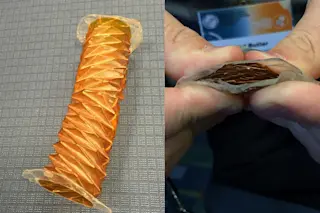Researchers at Brigham Young University developed this origami bellows for use on a martian rover. When compressed, at right, it folds to 1/30 its expanded size. (Credit: Liz Kruesi) Even though astronomy is my first love, sometimes I wander away and explore other science. This week, I attended a mechanical engineering conference and sat in on sessions specifically devoted to the influence of origami in engineering design. Lucky for me, there have been a few talks that combine this area of engineering with space-based applications. One of the coolest was a compressible tube whose structure is based on origami folds. This type of tube (called a bellows) has all kinds of uses on Earth — like connecting a jet bridge to an airplane’s open door — and in space, it can protect a smaller tool that lies inside the bellows but can extend out. The most advanced rover currently rolling ...
Putting origami to use in space
Discover how origami bellows for Martian rover enhance space exploration with a remarkable 1:30 compression ratio.
More on Discover
Stay Curious
SubscribeTo The Magazine
Save up to 40% off the cover price when you subscribe to Discover magazine.
Subscribe













